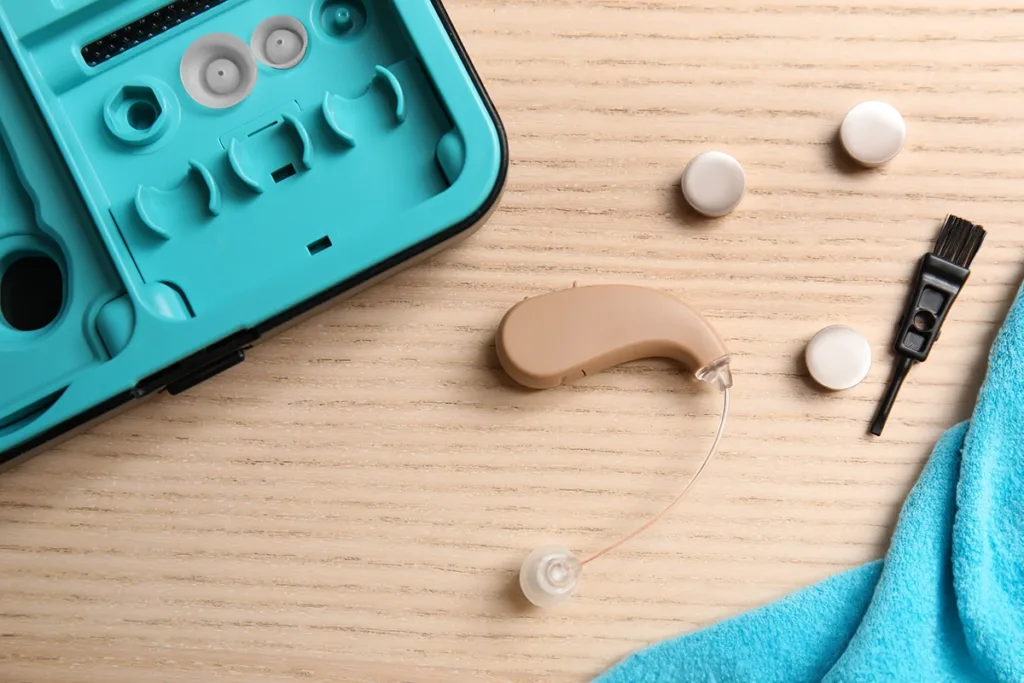Hearing aids are invaluable tools that can significantly enhance daily quality of life. To keep them in good working order and maximize their lifespan, having a daily hearing aid cleaning routine is essential. In this guide, we explain everything you need to know about how to properly clean your hearing aids at home, what tools to use, and how often to have them professionally deep cleaned.
The Importance of Properly Cleaning Your Hearing Aids
Like any electronic device, hearing aids require proper cleaning and routine maintenance to continue functioning correctly. They are designed to be worn every day, so exposure to sweat, body oils, humidity, and other potential contaminants is inevitable.
A daily hearing aid cleaning routine is essential because it allows for:
- Improved sound quality: Regular cleaning prevents wax and debris buildup, which ensures a comfortable fit, optimal performance, and clear sound.
- Maximum lifespan: Proper maintenance reduces the impact of daily wear and tear on hearing aids, reducing the need for repairs, and maximizing their lifespan.
- Better reliability: Making a habit of consistently cleaning your hearing aids keeps them free from moisture and debris that can cause malfunctions, ensuring they provide uninterrupted sound and speech clarity.
- Optimal comfort: Cleaning your hearing aids removes wax, dirt, and debris, preventing irritation and ensuring a secure fit in the ear canal1.
How Often Should You Clean Your Hearing Aids?
You should clean your hearing aids every day to maintain optimal fit and performance and to prevent malfunctions. Just like brushing your teeth, cleaning your hearing aids is an essential daily habit that will keep them in tip-top shape.
Cleaning them at the end of each day and placing them in a dehumidifier or drying kit overnight is an easy and effective routine for most hearing aid wearers.
Hearing Aid Cleaning Supplies Checklist
Using the right cleaning tools and supplies is crucial for maintaining the hygiene and performance of your hearing aids. Incorrect tools can scratch or damage delicate components, while incompatible cleaning solutions can cause corrosion or irritation.
Below is a list of common hearing aid supplies and what they are used for:
- Hearing aid brush: used to gently remove dirt and debris from the exterior of the hearing aid
- Microfiber cloth: a soft, lint-free cloth used to gently wipe away dirt, debris, fingerprints, and smudges
- Wax picks and loops: specialized tools used to remove earwax from the microphone, receiver, or other small components without damaging them
- Dehumidifier or drying kit: a device that removes natural moisture build-up from the interior of hearing aids to prevent damage
- Disinfectant wipes: cleans and sanitizes the exterior surfaces and prevents the growth of bacteria and mold
How to Properly Clean Your Hearing Aids

Different hearing aid styles may have specific cleaning requirements unique to their design, so refer to your owner’s manual for specific care instructions. However, the hearing aid cleaning routine outlined below will work for most styles:
Hearing Aid Cleaning Routine
- Wash your hands with soap and water and dry them thoroughly before handling your hearing aids.
- Turn your hearing aids off and remove the batteries.
- Use a hearing aid brush to remove any debris from the surface gently.
- Remove wax from the wax guard using a pick or loop tool.
- Wipe down the entire exterior surface using a soft, dry cloth. Avoid using wet wipes or any products with alcohol or strong cleaning chemicals.
- Place your hearing aid in a dehumidifier or drying kit overnight, keeping the battery compartment open to allow any internal moisture to evaporate.
By following these steps, you can keep your hearing aids clean and dry for maximum comfort and performance for years to come.
Other Hearing Aid Cleaning and Maintenace Tips:
- Always handle your hearing aids with care; wash your hands before handling them and only use tools and supplies designed specifically for hearing aids to avoid accidental damage.
- Avoid exposing your hearing aids to moisture as much as possible and place them in a drying kit or dehumidifier every night.
- Keep the battery compartment clean and moisture-free, and make sure to remove the batteries each time you clean your devices.
- Schedule routine cleaning and maintenance services with a hearing healthcare specialist.
How Often Should Hearing Aids Be Deep Cleaned?
Just like your vehicle needs routine tune-ups, your hearing aids need professional maintenance and cleaning every three to six months. The exact frequency will vary depending on your specific hearing needs, how much earwax you produce, and other factors that your care provider will go over with you.
During these appointments, your specialist will perform a hearing aid deep cleaning to remove any earwax, moisture, and debris from the exterior and interior of your device. They will also provide any required hearing aid setting adjustments to account for changes in your hearing needs or lifestyle.
Unless there is an electronic issue or damage to your hearing devices, these appointments are quick and easy, so you can get right back to your day with the best possible hearing experience.
Get Professional Hearing Aid Maintenance for Any Brand at Starkey HearCare in Shakopee
Daily home care, paired with regular professional cleanings can help preserve the performance, longevity, and comfort of your hearing aids for years to come. If you’re in need of professional hearing aid maintenance in Shakopee, contact our team at Starkey HearCare today. We are proud to offer new patient maintenance services on all hearing aid brands no matter where you bought them from.
References
- Orji, F. T., Onyero, E. O., & Agbo, C. E. (1969). The clinical implications of ear canal debris in hearing aid users. Pakistan Journal of Medical Sciences, 30(3). https://doi.org/10.12669/pjms.303.4742

